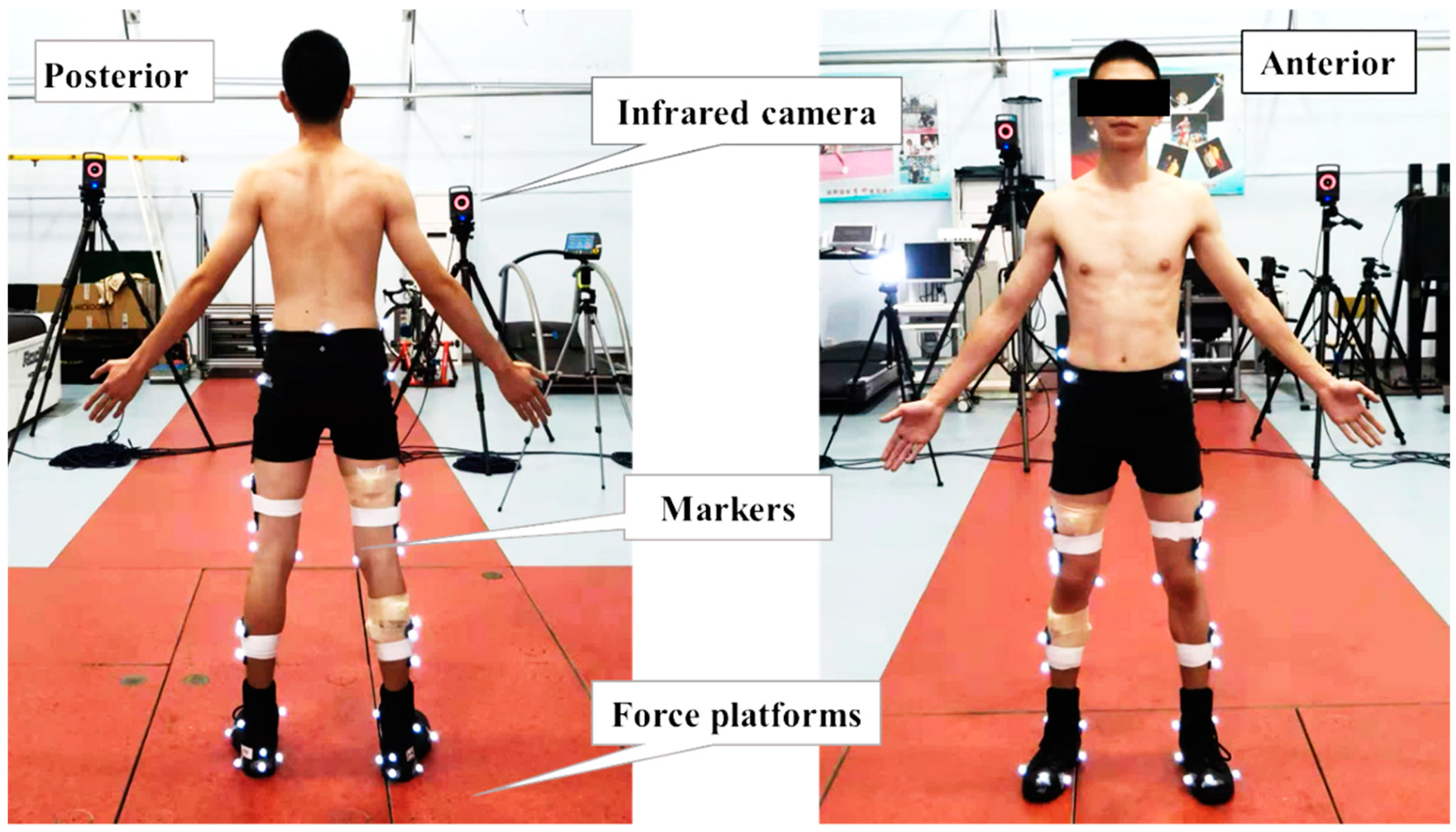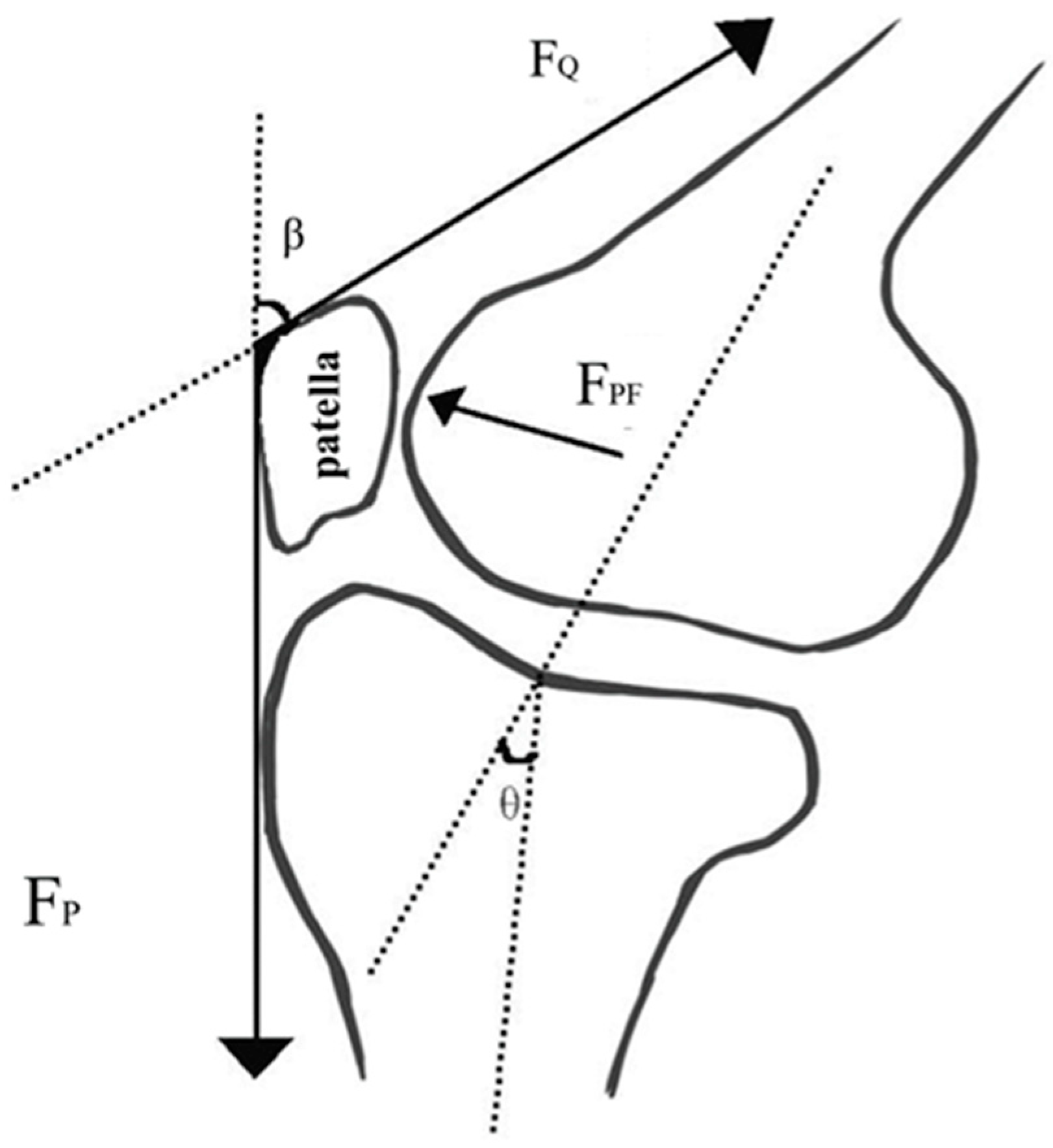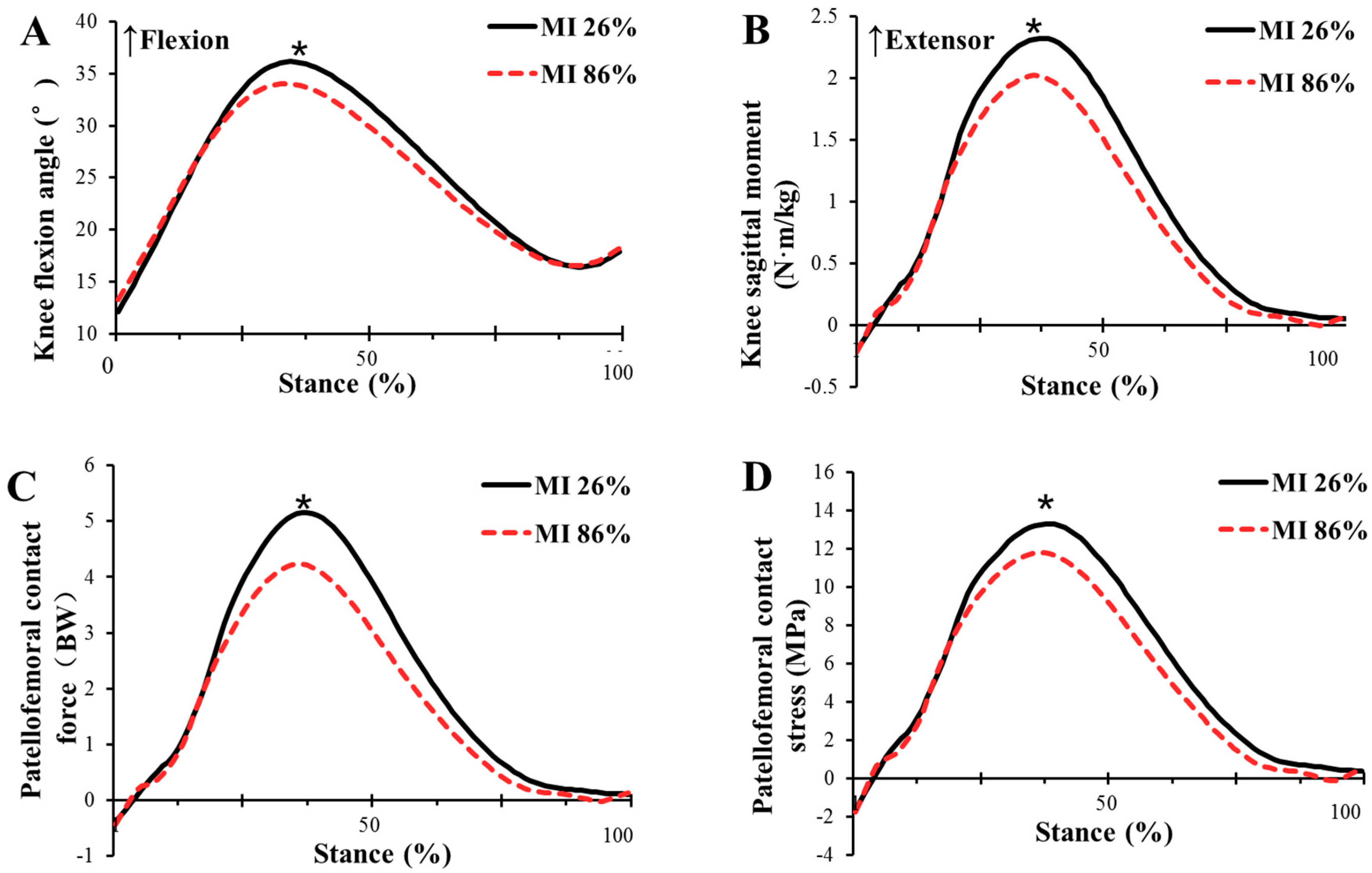Patellofemoral Joint Loads during Running Immediately Changed by Shoes with Different Minimalist Indices: A Cross-sectional Study
Abstract
1. Introduction
2. Materials and Methods
2.1. Participants
2.2. Shoe Conditions
2.3. Data Collection
2.4. Data Processing
2.5. Statistics
3. Results
3.1. GRF
3.2. Kinematics
3.3. Kinetics
4. Discussion
5. Conclusions
Author Contributions
Funding
Conflicts of Interest
References
- Van Gent, R.N.; Siem, D.; van Middelkoop, M.; van Os, A.G.; Bierma-Zeinstra, S.M.; Koes, B.W. Incidence and determinants of lower extremity running injuries in long distance runners: A systematic review. Br. J. Sports Med. 2007, 41, 469–480. [Google Scholar] [CrossRef] [PubMed]
- Ceyssens, L.; Vanelderen, R.; Barton, C.; Malliaras, P.; Dingenen, B. Biomechanical Risk Factors Associated with Running-Related Injuries: A Systematic Review. Sports Med. 2019, 49, 1095–1115. [Google Scholar] [CrossRef] [PubMed]
- Dutton, R.A.; Khadavi, M.J.; Fredericson, M. Patellofemoral Pain. Phys. Med. Rehabil. Clin. N. Am. 2016, 27, 31–52. [Google Scholar] [CrossRef] [PubMed]
- Jordan, M.J.; Aagaard, P.; Herzog, W. A comparison of lower limb stiffness and mechanical muscle function in ACL-reconstructed, elite, and adolescent alpine ski racers/ski cross athletes. J. Sport Health Sci. 2018, 7, 416–424. [Google Scholar] [CrossRef]
- Neal, B.S.; Barton, C.J.; Gallie, R.; O’Halloran, P.; Morrissey, D. Runners with patellofemoral pain have altered biomechanics which targeted interventions can modify: A systematic review and meta-analysis. Gait Posture 2016, 45, 69–82. [Google Scholar] [CrossRef] [PubMed]
- Del Coso, J.; Herrero, H.; Salinero, J.J. Injuries in Spanish female soccer players. J. Sport Health Sci. 2018, 7, 183–190. [Google Scholar] [CrossRef]
- Sinclair, J.; Richards, J.; Selfe, J.; Fau-Goodwin, J.; Shore, H. The Influence of Minimalist and Maximalist Footwear on Patellofemoral Kinetics During Running. J. Appl. Biomech. 2016, 32, 359–364. [Google Scholar] [CrossRef]
- Esculier, J.F.; Dubois, B.; Bouyer, L.J.; McFadyen, B.J.; Roy, J.S. Footwear characteristics are related to running mechanics in runners with patellofemoral pain. Gait Posture 2017, 54, 144–147. [Google Scholar] [CrossRef]
- Esculier, J.F.; Dubois, B.; Dionne, C.E.; Leblond, J.; Roy, J.S. A consensus definition and rating scale for minimalist shoes. J. Foot Ankl. Res. 2015, 8, 42. [Google Scholar] [CrossRef]
- Squadrone, R.; Rodano, R.; Hamill, J.; Preatoni, E. Acute effect of different minimalist shoes on foot strike pattern and kinematics in rearfoot strikers during running. J. Sports Sci. 2015, 33, 1196–1204. [Google Scholar] [CrossRef]
- Rice, H.M.; Jamison, S.T.; Davis, I.S. Footwear Matters: Influence of Footwear and Foot Strike on Load Rates during Running. Med. Sci. Sports Exerc. 2016, 48, 2462–2468. [Google Scholar] [CrossRef] [PubMed]
- Xia, R.; Zhang, X.; Wang, X.; Sun, X.; Fu, W. Effects of Two Fatigue Protocols on Impact Forces and Lower Extremity Kinematics during Drop Landings: Implications for Noncontact Anterior Cruciate Ligament Injury. J. Healthc. Eng. 2017, 2017, 5690519. [Google Scholar] [CrossRef] [PubMed]
- Sun, X.; Yang, Y.; Wang, L.; Zhang, X.; Fu, W. Do Strike Patterns or Shoe Conditions have a Predominant Influence on Foot Loading? J. Hum. Kinet. 2018, 64, 13–23. [Google Scholar] [CrossRef] [PubMed]
- Heino Brechter, J.; Powers, C.M. Patellofemoral stress during walking in persons with and without patellofemoral pain. Med. Sci. Sports Exerc. 2002, 34, 1582–1593. [Google Scholar] [CrossRef] [PubMed]
- Dos Santos, A.F.; Nakagawa, T.H.; Serrao, F.V.; Ferber, R. Patellofemoral joint stress measured across three different running techniques. Gait Posture 2019, 68, 37–43. [Google Scholar] [CrossRef] [PubMed]
- Vannatta, C.N.; Kernozek, T.W. Patellofemoral joint stress during running with alterations in foot strike pattern. Med. Sci. Sports Exerc. 2015, 47, 1001–1008. [Google Scholar] [CrossRef] [PubMed]
- Bressel, E. The influence of ergometer pedaling direction on peak patellofemoral joint forces. Clin. Biomech. 2001, 16, 431–437. [Google Scholar] [CrossRef]
- LaBella, C. Patellofemoral pain syndrome: Evaluation and treatment. Prim. Care 2004, 31, 977–1003. [Google Scholar] [CrossRef]
- Besier, T.F.; Gold, G.E.; Beaupre, G.S.; Delp, S.L. A modeling framework to estimate patellofemoral joint cartilage stress in vivo. Med. Sci. Sports Exerc. 2005, 37, 1924–1930. [Google Scholar] [CrossRef]
- Sinclair, J. Effects of barefoot and barefoot inspired footwear on knee and ankle loading during running. Clin. Biomech. 2014, 29, 395–399. [Google Scholar] [CrossRef]
- Kulmala, J.P.; Avela, J.; Pasanen, K.; Parkkari, J. Forefoot strikers exhibit lower running-induced knee loading than rearfoot strikers. Med. Sci. Sports Exerc. 2013, 45, 2306–2313. [Google Scholar] [CrossRef] [PubMed]
- Nigg, B.M.; Baltich, J.; Hoerzer, S.; Enders, H. Running shoes and running injuries: Mythbusting and a proposal for two new paradigms: ‘preferred movement path’ and ‘comfort filter’. Br. J. Sports Med. 2015, 49, 1290–1294. [Google Scholar] [CrossRef]
- Holowka, N.B.; Wynands, B.; Drechsel, T.J.; Yegian, A.K.; Tobolsky, V.A.; Okutoyi, P.; Mang’eni Ojiambo, R.; Haile, D.W.; Sigei, T.K.; Zippenfennig, C.; et al. Foot callus thickness does not trade off protection for tactile sensitivity during walking. Nature 2019, 571, 261–264. [Google Scholar] [CrossRef] [PubMed]
- Hasegawa, H.; Yamauchi, T.; Kraemer, W.J. Foot strike patterns of runners at the 15-km point during an elite-level half marathon. J. Strength Cond. Res. 2007, 21, 888–893. [Google Scholar] [CrossRef] [PubMed]
- Kasmer, M.E.; Liu, X.C.; Roberts, K.G.; Valadao, J.M. Foot-strike pattern and performance in a marathon. Int. J. Sports Physiol. Perform. 2013, 8, 286–292. [Google Scholar] [CrossRef]
- Bonacci, J.; Hall, M.; Saunders, N.; Vicenzino, B. Gait retraining versus foot orthoses for patellofemoral pain: A pilot randomised clinical trial. J. Sci. Med. Sport 2018, 21, 457–461. [Google Scholar] [CrossRef]
- Lieberman, D.E.; Venkadesan, M.; Werbel, W.A.; Daoud, A.I.; D’Andrea, S.; Davis, I.S.; Mang’eni, R.O.; Pitsiladis, Y. Foot strike patterns and collision forces in habitually barefoot versus shod runners. Nature 2010, 463, 531–535. [Google Scholar] [CrossRef]
- Perl, D.P.; Daoud, A.I.; Lieberman, D.E. Effects of footwear and strike type on running economy. Med. Sci. Sports Exerc. 2012, 44, 1335–1343. [Google Scholar] [CrossRef]
- Roper, J.L.; Harding, E.M.; Doerfler, D.; Dexter, J.G.; Kravitz, L.; Dufek, J.S.; Mermier, C.M. The effects of gait retraining in runners with patellofemoral pain: A randomized trial. Clin. Biomech. 2016, 35, 14–22. [Google Scholar] [CrossRef]
- Ervilha, U.F.; Mochizuki, L.; Figueira, A., Jr.; Hamill, J. Are muscle activation patterns altered during shod and barefoot running with a forefoot footfall pattern? J. Sports Sci. 2017, 35, 1697–1703. [Google Scholar] [CrossRef]
- Holowka, N.B.; Wallace, I.J.; Lieberman, D.E. Foot strength and stiffness are related to footwear use in a comparison of minimally- vs. conventionally-shod populations. Sci. Rep. 2018, 8, 3679. [Google Scholar] [CrossRef] [PubMed]
- Takabayashi, T.; Edama, M.; Nakamura, M.; Nakamura, E.; Inai, T.; Kubo, M. Gender differences associated with rearfoot, midfoot, and forefoot kinematics during running. Eur. J. Sport Sci. 2017, 17, 1289–1296. [Google Scholar] [CrossRef] [PubMed]




| Shoe | Weight (g) | Stack Height (mm) | Heel-to-Toe Drop (mm) | Stability and Motion Control Technologies | Flexibility | MI (%) |
|---|---|---|---|---|---|---|
| INOV-8 Bare-XF 210 V2 | 227 | 3 | 0 | None | longitudinal 360° torsional 360° | 86 |
| Subscore | 2 | 5 | 5 | 5 | 4.5 | |
| Nike Air Zoom Pegasus 34 | 285 | 30 | 7 | Four devices | longitudinal 45°–90° torsional 0°–45° | 26 |
| Subscore | 1 | 1 | 2 | 1 | 1.5 |
| Phase | Parameters | MI 26% | MI 86% | p |
|---|---|---|---|---|
| Touch-down | Knee flexion angle (°) | 12.64 ± 4.56 | 13.56 ± 5.60 | 0.637 |
| Ankle plantar flexion angle (°) | 0.13 ± 7.92 | 0.13 ± 4.29 | 0.835 | |
| Foot inclination angle (°) | 12.54 ± 2.18 | 8.07 ± 4.64 | <0.001 | |
| Stance phase | FP (BW) | 1.74 ± 0.23 | 1.78 ± 0.16 | 0.701 |
| SP (BW) | 2.59 ± 0.31 | 2.61 ± 0.25 | 0.559 | |
| Peak knee flexion angle (°) | 36.29 ± 3.41 | 33.93 ± 1.74 | 0.008 | |
| Peak patellofemoral joint contact area (mm2) | 280.10 ± 21.96 | 265.08 ± 10.20 | 0.008 | |
| Peak knee extension moment (N × m/kg) | 2.36 ± 0.41 | 2.07 ± 0.47 | <0.001 | |
| Peak patellofemoral contact force (BW) | 5.23 ± 1.12 | 4.34 ± 0.97 | <0.001 | |
| Peak patellofemoral contact stress (MPa) | 13.48 ± 2.64 | 12.08 ± 3.27 | 0.015 |
© 2019 by the authors. Licensee MDPI, Basel, Switzerland. This article is an open access article distributed under the terms and conditions of the Creative Commons Attribution (CC BY) license (http://creativecommons.org/licenses/by/4.0/).
Share and Cite
Yang, C.; Xiao, S.; Yang, Y.; Zhang, X.; Wang, J.; Fu, W. Patellofemoral Joint Loads during Running Immediately Changed by Shoes with Different Minimalist Indices: A Cross-sectional Study. Appl. Sci. 2019, 9, 4176. https://doi.org/10.3390/app9194176
Yang C, Xiao S, Yang Y, Zhang X, Wang J, Fu W. Patellofemoral Joint Loads during Running Immediately Changed by Shoes with Different Minimalist Indices: A Cross-sectional Study. Applied Sciences. 2019; 9(19):4176. https://doi.org/10.3390/app9194176
Chicago/Turabian StyleYang, Chenhao, Songlin Xiao, Yang Yang, Xini Zhang, Junqing Wang, and Weijie Fu. 2019. "Patellofemoral Joint Loads during Running Immediately Changed by Shoes with Different Minimalist Indices: A Cross-sectional Study" Applied Sciences 9, no. 19: 4176. https://doi.org/10.3390/app9194176
APA StyleYang, C., Xiao, S., Yang, Y., Zhang, X., Wang, J., & Fu, W. (2019). Patellofemoral Joint Loads during Running Immediately Changed by Shoes with Different Minimalist Indices: A Cross-sectional Study. Applied Sciences, 9(19), 4176. https://doi.org/10.3390/app9194176




